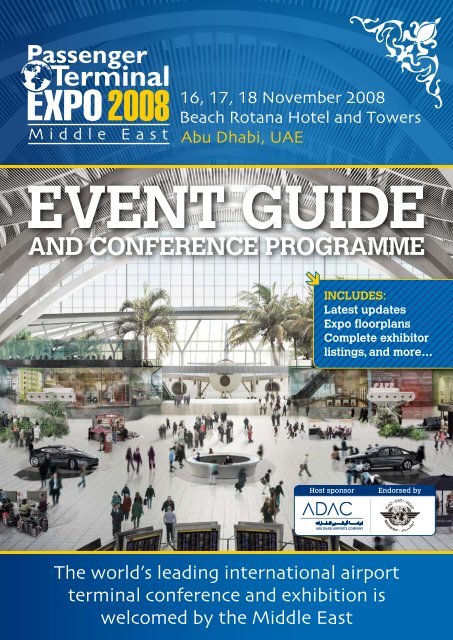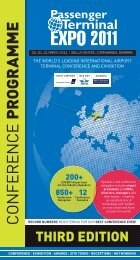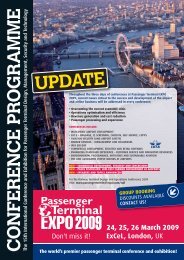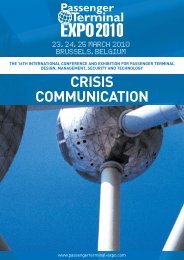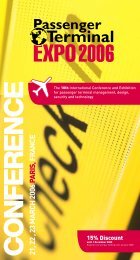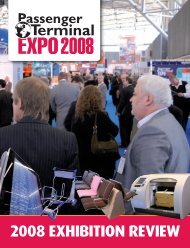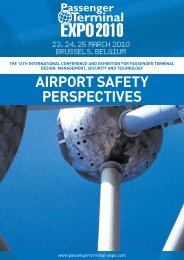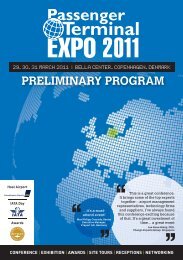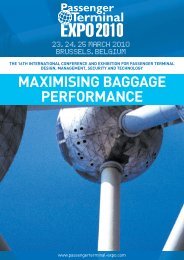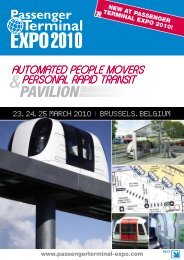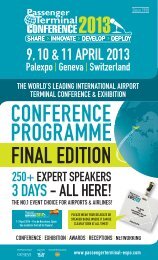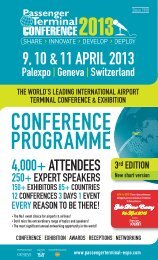and conference programme - Passenger Terminal Expo
and conference programme - Passenger Terminal Expo
and conference programme - Passenger Terminal Expo
Create successful ePaper yourself
Turn your PDF publications into a flip-book with our unique Google optimized e-Paper software.
M i d d l e E a s t<br />
event guide<br />
<strong>and</strong> <strong>conference</strong> <strong>programme</strong><br />
Includes:<br />
Latest updates<br />
<strong>Expo</strong> floorplans<br />
Complete exhibitor<br />
listings, <strong>and</strong> more…<br />
Host sponsor<br />
Endorsed by
useful information<br />
Conference rooms with floorplan<br />
Room Key<br />
n Almas Suite 1<br />
n Almas Suite 2<br />
n Almas Suite 3<br />
n Al Thuraya A<br />
n Al Thuraya B<br />
n Al Thuraya C<br />
n Speaker room<br />
n Show management<br />
Almas<br />
Suite 3<br />
Almas<br />
Suite 2<br />
Almas<br />
Suite 1<br />
Al Thuraya C Al Thuraya B Al Thuraya A<br />
Conference<br />
delegate<br />
refreshments<br />
Conference<br />
delegate<br />
dining<br />
Lunches will be held in Al Thuraya B.<br />
Refreshment breaks will be held in<br />
Al Thuraya C.<br />
After lunch coffee will be held in<br />
Al Thuraya C.<br />
Speaker<br />
Room<br />
ENTRANCE<br />
FROM LOBBY<br />
Day one<br />
Sunday 16 November 2008<br />
Al Thuraya A<br />
Opening Forum - Plenary session<br />
B.IT.S - Technology <strong>and</strong> the passenger<br />
B.IT.S - Barcoded Boarding<br />
Passes (BCBP)<br />
B.IT.S - Baggage management<br />
Almas Suite 2<br />
Aviation security<br />
Security screening<br />
Security planning <strong>and</strong> design<br />
Almas Suite 3<br />
Airport development – planning,<br />
solutions, delivery<br />
Almas Suite 1<br />
Customer service <strong>and</strong> considerations<br />
passenger flow solutions<br />
Day two<br />
monday 17 November 2008<br />
Al Thuraya A<br />
International airport hub development<br />
importance of an operational readiness<br />
<strong>programme</strong> for openings<br />
Almas Suite 1<br />
Emerging trends <strong>and</strong> challenges in<br />
border control<br />
Almas Suite 2<br />
IATA – safely managing explosive<br />
capacity growth<br />
commercial development<br />
Almas Suite 3<br />
WORKSHOP - Using simulation for<br />
passenger terminal design <strong>and</strong> analysis<br />
Day three<br />
tuesday 18 November 2008<br />
Almas Suite 2<br />
Operational readiness <strong>and</strong> operations<br />
optimisation<br />
Almas Suite 3<br />
Airport development - Middle East<br />
Airport development - India<br />
Almas Suite 1<br />
B.IT.S - Systems integration <strong>and</strong><br />
operation<br />
Gala Dinner Extravaganza at the<br />
Emirates Palace on the 17th November!<br />
6.30pm - Complimentary bus service to the Emirates<br />
Palace from the Beach Rotana Hotel & Towers<br />
7.00pm – Welcome drinks<br />
Ayallah dancers • Live Kamal Arabic fusion b<strong>and</strong><br />
Hosted by<br />
8.00pm - Buffet dinner with mezze • Live BBQ cooking<br />
stations • Oud player • Yolla dancers • Falcon h<strong>and</strong>ler •<br />
Calligrapher • Fire dancers • And more…!<br />
www.pteme.com
Conferences by day – at a glance<br />
Day one: Sunday 16 November 2008<br />
08.00. Conference delegate registration, badge collection<br />
<strong>and</strong> refreshments on arrival<br />
Opening Forum - Plenary Session..................................................................... 09.00-11.00..........Page 10<br />
B.IT.S - Technology <strong>and</strong> the <strong>Passenger</strong>............................................................ 11.20-12.20..........Page 10<br />
Session sponsored by<br />
B.IT.S - BarCoded Boarding Passes (BCBP)........................................................ 14.00-15.30..........Page 11<br />
Session sponsored by<br />
B.IT.S - Baggage Management.............................................................................. 15.45-17.30..........Page 12<br />
Session sponsored by<br />
Aviation Security................................................................................................... 11.20-12.50..........Page 13<br />
Security Screening............................................................................................... 14.00-15.30..........Page 13<br />
Security Planning <strong>and</strong> Design.......................................................................... 15.45-17.15..........Page 14<br />
Airport Development - Planning, Solutions, Delivery.............................. 14.00-17.15..........Page 15<br />
Session sponsored by<br />
Customer Service <strong>and</strong> Considerations.......................................................... 14.00-15.30..........Page 16<br />
<strong>Passenger</strong> Flow Solutions................................................................................. 15.45-17.15..........Page 17<br />
Day two: Monday 17 November 2008<br />
08.00. Conference delegate registration, badge collection <strong>and</strong> refreshments on arrival<br />
International Airport Hub Development...................................................... 10.00-12.15..........Page 18<br />
Importance of an Operational Readiness Programme for Openings... 14.00-16.50..........Page 19<br />
Emerging Trends <strong>and</strong> Challenges in Border Control.............................. 09.00-17.30..........Page 20<br />
IATA – Safely Managing Explosive Capacity Growth ................. 09.00-13.00..........Page 23<br />
Commercial Development................................................................................... 14.00-16.00..........Page 24<br />
WORKSHOP - Using Simulation for<br />
<strong>Passenger</strong> <strong>Terminal</strong> Design <strong>and</strong> Analysis...................................................... 09.00-13.00..........Page 26<br />
Day three: TueSday 18 November 2008<br />
09.00. Conference delegate registration, badge collection <strong>and</strong> refreshments on arrival<br />
Operational Readiness <strong>and</strong> Operations Optimisation............................... 10.00-13.15..........Page 26<br />
Airport Development – Middle East ................................................................ 10.00-11.30..........Page 28<br />
Session sponsored by<br />
Airport Development – India ............................................................................. 11.45-13.15..........Page 29<br />
Session sponsored by<br />
B.IT.S - Systems Integration <strong>and</strong> Operation.................................................... 10.00-12.45..........Page 29<br />
Session sponsored by<br />
www.pteme.com
Day one: Sunday 16 November 2008<br />
start<br />
08.00 Conference delegate registration, badge collection <strong>and</strong> refreshments<br />
on arrival<br />
Continental<br />
Airlines<br />
Opening Forum – Plenary session<br />
Please note: Each presentation’s allotted time includes five minutes for questions.<br />
Chairman: Brian Keene, director airport services, Continental Airlines, USA<br />
09.00-09.15 A welcome address <strong>and</strong> overview of the <strong>conference</strong><br />
HE Khalifa Mohamed Al Mazrouei, chairman <strong>and</strong> managing director,<br />
Abu Dhabi Airports Company (ADAC), UAE<br />
The chairman of ADAC will welcome delegates, give an overview of the <strong>conference</strong> <strong>and</strong> share<br />
with the audience some of the aviation developments taking place in the Emirate of Abu Dhabi.<br />
09.15-09.50 Meeting the dem<strong>and</strong>s of a dynamic aviation market<br />
Rudy Vercelli, CEO, Abu Dhabi Airports Company (ADAC), UAE<br />
How ADAC is meeting the differing dem<strong>and</strong>s of the growing <strong>and</strong> dynamic aviation marketplace<br />
through a range of products <strong>and</strong> business initiatives. Mr Vercelli will also give an insight into<br />
ADAC’s international ambitions.<br />
Room:<br />
Al Thuraya A<br />
Opening Forum – Plenary session<br />
DAY ONE 16 November 2008<br />
Continental<br />
Airlines<br />
09.50-10.25 The Middle East: developing a sustainable global aviation hub<br />
James Hogan, CEO, Etihad Airways, UAE<br />
How Middle Eastern airlines are recalibrating the global industry. New route development<br />
<strong>and</strong> fleet expansion. The potential of regional markets. International passenger forecast. Are<br />
location <strong>and</strong> infrastructure enough to attract market share Present <strong>and</strong> predicted impact of<br />
the airline on Abu Dhabi’s economic <strong>and</strong> social growth. How are the developments in aviation<br />
shaping the local economy<br />
10.25-11.00 Non-aeronautical revenue streams<br />
Rimzie Ismail, general manager marketing (on behalf of Paul Griffiths, CEO),<br />
Dubai Airports, UAE<br />
11.00-11.20 Refreshment break<br />
B.IT.S – Technology <strong>and</strong> the <strong>Passenger</strong><br />
Please note: Each presentation’s allotted time includes five minutes for questions.<br />
Chairman: Brian Keene, director airport services, Continental Airlines, USA<br />
Room:<br />
Al Thuraya A<br />
B.IT.S – Barcoded Boarding Passes (BCBP)<br />
DAY ONE 16 November 2008<br />
www.pteme.com
11.20-11.50 How technology drives the Emirates seamless passenger experience<br />
Rob Broere, vice-president - IT passenger services systems <strong>and</strong> passenger<br />
experience, Emirates Group (Emirates Airline, Dnata <strong>and</strong> Mercator), UAE<br />
Emirates is an airline for which the passenger experience is key to its success <strong>and</strong> growth.<br />
During this presentation the audience will be able to see how Emirates has been deploying<br />
technology to improve the experience while still keeping a tight control on costs. This also<br />
includes features of the new Emirates-only <strong>Terminal</strong> 3 in Dubai <strong>and</strong> the recently introduced<br />
A380. The audience will learn how technology can improve the experience of customers. It<br />
will also explain how close cooperation between Emirates <strong>and</strong> its prime IT supplier, Mercator,<br />
has been very beneficial.<br />
11.50-12.20 IT&T as enabler <strong>and</strong> facilitator for successfully managing airport<br />
passenger experiences<br />
Leonidas Daravelis, manager, acting head of IT <strong>and</strong> telecommunications<br />
business unit, Athens International Airport SA, Greece<br />
The presentation will identify the role of the IT&T business unit in Athens International<br />
Airport in enabling <strong>and</strong> facilitating airport passenger operational activities. Following a short<br />
presentation of the IT&T business unit services <strong>and</strong> activities, the speaker will provide an indepth<br />
overview of the IT&T active role in current <strong>and</strong> future passenger-focused activities in<br />
the airport. The presentation aims to use the Athens International Airport example as a case<br />
study to show how the IT&T business unit can actively lead/manage/support any passengerrelated<br />
operational activity in any airport, resulting in savings <strong>and</strong> economies of scale.<br />
12.20-14.00 Lunch – networking lunch in the Delegate Dining Area<br />
B.IT.S – Barcoded Boarding Passes (BCBP)<br />
Please note: Each presentation’s allotted time includes five minutes for questions.<br />
14.00-14.30 Boarding passes on mobile phones<br />
Alexis Hernot, marketing <strong>and</strong> strategy vice-president, IER, France<br />
Self-service <strong>and</strong> off-site check-in is a major trend in the industry. Nonetheless, until recently<br />
it was necessary to have a printer on h<strong>and</strong> to print the boarding pass. This is now history,<br />
as passengers can receive their boarding pass on their mobile phone. In addition to the<br />
outst<strong>and</strong>ing passenger experience, this new technology offers opportunities for br<strong>and</strong>ing<br />
<strong>and</strong> advertising.<br />
14.30-15.00 Airport preparation for IATA mobile phone boarding cards<br />
Alaistair Deacon, technical director, Real Time Engineering, UK<br />
In October 2007, IATA announced the extension of Resolution 792 to allow the delivery of<br />
boarding passes to mobile phones <strong>and</strong> PDAs. This presentation will look at the impact of this<br />
resolution, particularly on the equipment, processes <strong>and</strong> procedures that airports will need<br />
to put in place. The presentation will include a case study of the launch of bmi’s ‘paperless<br />
boarding’, <strong>and</strong> the preparation behind getting the airports, including London Heathrow, ready<br />
for successful go-live.<br />
Room:<br />
Al Thuraya A<br />
B.IT.S – Barcoded Boarding Passes (BCBP)<br />
DAY ONE 16 November 2008<br />
15.00-15.30 Credential use in passenger transit, airport operations <strong>and</strong> security<br />
Jan van der Sluis, senior manager, identity <strong>and</strong> credentialing solutions,<br />
Unisys, The Netherl<strong>and</strong>s<br />
Credentials are tokens (cards, mobile phones, e-passports or even printed matter) that bear<br />
in some form the identity of a citizen/passenger for a certain purpose. For border control, in<br />
combination with biometrics as an application, or for internal operations <strong>and</strong> logistics/security,<br />
there are best practices for using credentials <strong>and</strong> benefits for the airline industry <strong>and</strong> the<br />
www.pteme.com
passenger. New technologies for facilitation will be addressed, <strong>and</strong> the concept of using<br />
credentials in the airline sector will be approached from many different angles. It will also<br />
be made clear that a credential-based system must come with a solid architecture, business<br />
case <strong>and</strong> support level to ensure customer acceptance <strong>and</strong> appreciation.<br />
15.30-15.45 Refreshment break<br />
B.IT.S – Baggage Management<br />
Please note: Each presentation’s allotted time includes five minutes for questions.<br />
15.45-16.15 Baggage sorting <strong>and</strong> 100% x-ray screening at Stuttgart Airport<br />
Uwe Kaschdailewitsch, head of department conveying <strong>and</strong> machine<br />
technology, Flughafen Stuttgart GmbH, Germany<br />
In 2004 the new <strong>Terminal</strong> 3 went into operation at Stuttgart Airport, with a baggage h<strong>and</strong>ling<br />
system that integrated 100% x-ray screening for the first time in Stuttgart. The heart of the<br />
system is a tilt-tray sorter on which every piece of luggage will find its way to the planned<br />
destination. In 2008, <strong>Terminal</strong> 1’s baggage h<strong>and</strong>ling system was replaced. Because of the<br />
small dimensions of the building, it was not possible to install a tilt-tray sorter. Fortunately<br />
there is no need for level-two x-rays, so we were able to solve the problem with a<br />
conventional belt-conveyer system.<br />
Room:<br />
Al Thuraya A<br />
B.IT.S – Baggage Management<br />
DAY ONE 16 November 2008<br />
16.15-16.40 Using emulation to secure baggage h<strong>and</strong>ling systems on time<br />
Kim Madsen, system manager, software engineering, FKI Logistex, Denmark<br />
Singapore Changi Airport recently opened its new <strong>Terminal</strong> 3. At the design phase, emulation<br />
was the backbone of making the BHS. Based on the Changi Airport case study, the next<br />
generation of emulation will be presented, including examples of how far emulation can be<br />
taken to visualise possible airport scenarios that can impact baggage h<strong>and</strong>ling. The audience<br />
will learn how this type of test will subject the baggage h<strong>and</strong>ling system to a variety of<br />
scenarios <strong>and</strong> force the layout <strong>and</strong> control system to deal with future dem<strong>and</strong>s for higher<br />
performance due to exp<strong>and</strong>ing passenger numbers. In addition, the use of emulation can help<br />
visualise <strong>and</strong> prove the system layout to non-mechanical <strong>and</strong> non-software oriented people<br />
16.40-17.05 Increasing profitability <strong>and</strong> baggage performance: is RFID right for you<br />
Jean-Noel Lefebvre, partner, Aera.aero Consultants, France<br />
This presentation will provide an update on what RFID for bag tags bring, <strong>and</strong> insights into<br />
how to do a fact-based assessment of RFID ROI <strong>and</strong> make the right decision for an airport<br />
or terminal.1) How to use track-<strong>and</strong>-trace databases, RFID, barcode h<strong>and</strong>-helds to deliver<br />
better baggage performance; 2) How to decrease tag cost; 3) How to investigate key benefits<br />
of RFID for the main baggage flows; 4) How to identify opportunities to go towards 6-Sigma<br />
performance; 5) What are the key success factors, particularly with stakeholders (airport,<br />
airlines, h<strong>and</strong>lers, etc.)<br />
17.05-17.30 Automated <strong>and</strong> unmanned bag drop<br />
Alexis Hernot, marketing <strong>and</strong> strategy vice-president, IER, France<br />
We will describe the process <strong>and</strong> product that we have designed with major airlines to allow<br />
passengers to drop a bag in less than 30 seconds. Such technology opens the way for global<br />
optimisation of check-in resources that has not happened since the introduction of check-in<br />
kiosks. This system is based on the use of state-of-the-art technologies in the industry: RFID<br />
<strong>and</strong> self-service technology. I will explain different solutions for bag drops <strong>and</strong> their impact on<br />
airline resources as well as passengers. Then we will explore the critical success factors for a<br />
fast bag drop <strong>and</strong> successful implementation in existing infrastructure.<br />
www.pteme.com
Aviation Security<br />
Please note: Each presentation’s allotted time includes five minutes for questions.<br />
Chairman: Billie Vincent, president <strong>and</strong> CEO, Aerospace Services<br />
International Inc, USA<br />
11.20-11.50 Future airports: security <strong>and</strong> facilitation in the Middle East<br />
Dr Abdulla Al Hashimi, divisional senior vice-president – Emirates Group<br />
Security/CEO – Transguard Group, Emirates Airline/ Transguard Group, UAE<br />
This paper will look at future airport development in the Middle East, specifically considering<br />
the new terminal <strong>and</strong> concourse at Dubai International Airport. The questions the paper will<br />
attempt to answer will deal with how security <strong>and</strong> facilitation are being considered in the<br />
planning <strong>and</strong> development of these airports, as well as the impact on the security function<br />
of Emirates in meeting these additional roles. The audience will leave with an underst<strong>and</strong>ing<br />
of how Emirates Group Security has addressed the issues surrounding future airports<br />
development while still maintaining business continuity.<br />
Room:<br />
Almas Suite 2<br />
Aviation Security<br />
DAY ONE 16 November 2008<br />
11.50-12.20 Optimising cost-effective technologies to build first-class security<br />
infrastructure<br />
Dr Khaled Almazroui, general manager, Fujairah International Airport, UAE<br />
The speaker will look at ways to assess vulnerability <strong>and</strong> risk levels, identify infrastructural<br />
needs associated with threats, <strong>and</strong> innovatively make use of cost-effective technologies.<br />
Attendees will learn about biometric utilisation in general <strong>and</strong> for airports in particular. They<br />
will also learn about the types of biometrics used in the UAE airports <strong>and</strong> discover the most<br />
suitable biometric systems for airports<br />
12.20-12.50 Do we need aviation security legislation in the Arab region<br />
Yousuf Wali, president, Arabian Falcons Aviation Service, Saudi Arabia<br />
The Arab region is in need of basic legislation in aviation security to foster the infrastructure<br />
of the air transport industry. Not all Arab countries have yet established their own national<br />
civil aviation security <strong>programme</strong>. Many carriers have also not submitted their OSPs to<br />
the host country. There is a message across the board that most CAA concerns are about<br />
the international outlook rather than the basics. NCASP is the number-one priority in the<br />
infrastructure of the civil aviation regime – it is an international requirement by ICAO/IATA <strong>and</strong><br />
international organisations.<br />
12.50-14.00 Lunch – networking lunch in the Delegate Dining Area<br />
Security Screening<br />
Please note: Each presentation’s allotted time includes five minutes for questions.<br />
14.00-14.30 Cost reduction through automated flow control <strong>and</strong> detection of people<br />
Dr Christian Bogatu, external researcher, University of Technology<br />
Berlin, Germany<br />
At various locations within airports, there is an opportunity to reduce the number of human<br />
security guards by deploying smart, reliable, automated radar-based screening solutions.<br />
Detecting people in secure areas, preventing people from entering such areas as well as<br />
ensuring a controlled flow of passengers are important tasks at airports. While security is<br />
crucial for safe <strong>and</strong> secure operation of the airport, it is a major financial outlay, particularly<br />
Room:<br />
Almas Suite 2<br />
Security Screening<br />
DAY ONE 16 November 2008<br />
www.pteme.com
if human guards need to be deployed. Automated detection not only reduces the operational<br />
costs to airports but also eliminates the possibility of human errors.<br />
14.30-15.00 Relationship between screeners <strong>and</strong> passengers in Japan’s airport security<br />
Toki Udagawa, PhD c<strong>and</strong>idate, University of Tokyo, Japan<br />
Airport service includes airport security. But passengers <strong>and</strong> security screeners, particularly<br />
in Japan, do not underst<strong>and</strong> this formula. <strong>Passenger</strong>s often become ‘monster passengers’,<br />
aiming unreasonable complaints towards security screeners. The security screeners cannot<br />
deal with such passengers appropriately because they do not have any authorised power. This<br />
presentation will focus on the view from security screeners <strong>and</strong> will discuss this serious issue.<br />
15.00-15.30 Towards baggage h<strong>and</strong>ling improvement: stop moving bags!<br />
Move their images!<br />
Jean Salomon, principal, JSCP Jsalomon Consulting Partners, France<br />
Decreasing the overall mean connect time <strong>and</strong> the correlated improved bag h<strong>and</strong>ling remain<br />
major challenges, particularly for high transfer-rate airports <strong>and</strong> hubs. Control authorities<br />
recently recognised that transfer rescreening does not add to the baggage security chain.<br />
This presentation suggests doing even more… potentially for less! How By using 20-yearold,<br />
well-established international st<strong>and</strong>ards for medical image transfers across hospitals<br />
worldwide. Bag re-examination is achieved by pulling data captured at origin through a<br />
secure internet link. Specific searches for drugs <strong>and</strong> biosecurity would benefit as well, thereby<br />
reducing destination re-screening. Benefits <strong>and</strong> deployment scenarios are discussed.<br />
15.30-15.45 Refreshment break<br />
Security Planning <strong>and</strong> Design<br />
Please note: Each presentation’s allotted time includes five minutes for questions.<br />
15.45-16.15 Architects, designers, engineers, clients <strong>and</strong> aviation security master plans<br />
Billie Vincent, president <strong>and</strong> CEO, Aerospace Services International Inc, USA<br />
Clients, architects, designers <strong>and</strong> engineers continue to make the mistake of waiting too long<br />
to bring aviation security experts into the design mix when building new, or renovating existing,<br />
airports. As a consequence, opportunities are missed for including some essential elements<br />
of aviation security into airport design. One major failure in the current threat environment<br />
is addressing vehicle-borne improvised explosive devices (VBIED), which has not been done<br />
adequately at airports anywhere in the world. The speaker will inject a sense of urgency into<br />
the process of designing or renovating airports from an aviation security st<strong>and</strong>point.<br />
Room:<br />
Almas Suite 2<br />
Security Planning <strong>and</strong> Design<br />
DAY ONE 16 November 2008<br />
16.15-16.45 Global best practices for world-class airport passenger terminal security<br />
Michael Minieri, senior director, Kroll Security Group, UAE<br />
This presentation reviews contemporary practices, strategies, concepts <strong>and</strong> technologies in<br />
architectural security, operational security <strong>and</strong> technological security for passenger terminals<br />
from arrival on the premises to departure from the gate. It addresses physical security,<br />
passenger screening, baggage screening <strong>and</strong> other critical issues for integrating effective<br />
security with efficient terminal operations. It also identifies <strong>and</strong> profiles the various types of<br />
security adversaries <strong>and</strong> the threats they pose to passenger terminals, along with essential<br />
countermeasure concepts. The speaker will also outline the global best practices in total<br />
security integration for comprehensive security risk mitigation, <strong>and</strong> the roles of public <strong>and</strong><br />
private security personnel for effective deployment.<br />
www.pteme.com
16.45-17.15 Humanising security<br />
Geoffrey Lee, managing principal, Woodhead Pty Ltd, Australia<br />
The human fantasy of flight has been lost due to the threat of terrorism <strong>and</strong> high-tech<br />
machinery dominating airport environments. We use technologies to protect us but we must<br />
reinstate the human element of interaction <strong>and</strong> refrain from treating individuals as objects. By<br />
using design elements such as line, texture, colour <strong>and</strong> shape, designers can learn from the past<br />
<strong>and</strong> take a leading step in humanising future security design. This paper will provide current<br />
international benchmarking knowledge, comparative studies <strong>and</strong> trend analysis for security<br />
concepts <strong>and</strong> planning, <strong>and</strong> interactive interior design. This information will benefit airport<br />
owners <strong>and</strong> managers, designers <strong>and</strong> planners in underst<strong>and</strong>ing <strong>and</strong> plotting future trends.<br />
Airport Development – Planning, Solutions, Delivery<br />
Please note: Each presentation’s allotted time includes five minutes for questions.<br />
Chairman: Pat Askew, principal, Perkins+Will, USA<br />
14.00-14.30 Airport, intermodality <strong>and</strong> regional development – a case study of<br />
sustainable planning<br />
Giulio De Carli, managing partner, One Works Spa, Italy<br />
The presentation will describe the case study of the new Venice international airport master<br />
plan. It will include the approval process <strong>and</strong> strategic guidelines of this model project that<br />
will develop Marco Polo Airport into a modern <strong>and</strong> efficient intermodality node on the EU TEN-<br />
T corridor 5.<br />
14.30-15.00 Skylink – the way from construction to operation<br />
Peter Mayerhofer, head of terminal management <strong>and</strong> project manager<br />
Skylink, Vienna International Airport, Austria<br />
The way from construction to operation is challenging, <strong>and</strong> good preparation is crucial for a<br />
successful start-up of a new terminal. With the structural work of our new terminal Skylink<br />
nearly finished, the completion of the interior ongoing, <strong>and</strong> the opening fast approaching, it<br />
was time to start a new project to cover all matters related to operational readiness. Within<br />
this project we are going to plan all the necessary concepts <strong>and</strong> arrangements for interactions<br />
with the future users to ensure a smooth <strong>and</strong> successful opening.<br />
Room:<br />
Almas Suite 3<br />
Airport Development – Planning, Solutions, Delivery<br />
DAY ONE 16 November 2008<br />
15.00-15.30 Air-rail intermodality – the options<br />
Andrew Sharp, director general, International Air Rail Organisation, UK<br />
The speaker will analyse the range of solutions that have been developed worldwide to<br />
provide rail access to airports for passengers <strong>and</strong> cargo. The advantages <strong>and</strong> disadvantages<br />
of the different types will be discussed, as will add-ons such as off-airport check-in. The<br />
audience will learn what is currently being done in cities around the world to improve ground<br />
access to airports by rail, <strong>and</strong> which solutions work where. They will learn about the issues<br />
affecting specific types of system <strong>and</strong> the choices available to them. They will also learn<br />
about the potential of rail to carry cargo to <strong>and</strong> from airports, <strong>and</strong> where this solution works.<br />
15.30-15.45 Refreshment break<br />
www.pteme.com
15.45-16.15 The new Indianapolis midfield terminal: meeting dem<strong>and</strong>s<br />
<strong>and</strong> expectations<br />
Richard Potosnak, president, Transportation Consulting <strong>and</strong> Management, USA<br />
The new Indianapolis International Airport is opening in October 2008. The <strong>programme</strong>,<br />
concept <strong>and</strong> budgets were developed during the project definition phase in 2000. This<br />
presentation will offer insights into how the original cost estimates <strong>and</strong> design concept<br />
that were developed in the project definition phase have withstood the pressures of cost<br />
escalation, security measures (both passenger <strong>and</strong> baggage), changes in the airline industry/<br />
aircraft fleets <strong>and</strong> continued global interest in sustainability. The US$1.1 billion project entails<br />
a new 40-gate terminal on two square miles between two runways. With the project near<br />
completion, it remains within budget.<br />
16.15-16.45 Airport construction: on time, on budget <strong>and</strong> state-of-the-art<br />
Axel Laistner, CEO, Axel Laistner Consulting, Germany<br />
With the proliferation of airport development projects worldwide <strong>and</strong> increasing airport<br />
privatisations, fiscal, schedule <strong>and</strong> operational responsibilities are ever more in dem<strong>and</strong>. What<br />
are the general or specific operational frameworks <strong>and</strong> criteria that let some projects succeed<br />
while others stumble Let’s explore the tightrope dance between investor control <strong>and</strong> design<br />
creativity. How to implement decision-making structures at large airport projects How to<br />
give architects <strong>and</strong> engineers the necessary leeway for creative solutions How to keep them<br />
focused on the project principles <strong>and</strong> aims How to ensure continuous control over budget,<br />
timeline <strong>and</strong> functionality for the airport operator<br />
16.45-17.15 Decreasing risk <strong>and</strong> increasing value on aviation projects<br />
Tony Potter, partner, Davis Langdon LLP, UK<br />
<strong>Passenger</strong> terminals are among the most complex buildings to design <strong>and</strong> deliver. They<br />
involve numerous stakeholders, many with opposing or conflicting requirements. Establishing<br />
a robust brief requires an approach that reconciles conflicting objectives <strong>and</strong> assists the<br />
team to put in place the conditions for success from the outset. Benchmarking helps the<br />
client bodies <strong>and</strong> end-users define the facilities they need at a cost they can afford. Strategic<br />
workshops enable the delivery team to underst<strong>and</strong> these needs <strong>and</strong> develop a balanced brief<br />
that meets expectations. The same process puts in place the means to make decisions based<br />
on maximising value <strong>and</strong> the means to manage risk.<br />
Customer Service <strong>and</strong> Considerations<br />
Please note: Each presentation’s allotted time includes five minutes for questions.<br />
Chairman: Hiosvany Muina, airport manager, Copa Airlines, USA<br />
14.00-14.30 Creating a positive customer experience<br />
Hiosvany Muina, airport manager, Copa Airlines, USA<br />
With today’s aviation industry challenges, we need to focus all of our resources on gaining<br />
<strong>and</strong> retaining our customers, internal as well as external. For this, we need to develop<br />
impactful, creative, positive customer experiences that will keep them coming back for<br />
more, <strong>and</strong> tell their friends about it too! The speaker will present methods, procedures <strong>and</strong><br />
techniques to elevate <strong>and</strong> increase customer satisfaction. The presentation will also show<br />
how to develop a customer service vision for your team <strong>and</strong> turn compliance into commitment<br />
by encouraging each team member to provide world-class customer service.<br />
Room:<br />
Almas Suite 1<br />
Customer Service <strong>and</strong> Considerations<br />
DAY ONE 16 November 2008<br />
www.pteme.com
14.30-15.00 High-class VIP procedures – possibility of airport cooperation<br />
Thomas Penner, vice-president terminal <strong>and</strong> passenger services, Munich<br />
International Airport, Germany<br />
15.00-15.30 Technology solutions for responding to EU PRM initiatives – ‘learning<br />
from our past’<br />
Tom Farmakis, project manager, DALGlobal Services LLC – a wholly owned<br />
subsidiary of Delta Airlines, USA<br />
The presentation will look at the US regulatory environment <strong>and</strong> the response to common<br />
industry problems faced when h<strong>and</strong>ling PRMs, VIPs <strong>and</strong> children travelling alone. It will also<br />
examine why technology solutions are needed <strong>and</strong> discuss lessons learned from two years<br />
of technology solution experience at Oakl<strong>and</strong> International Airport in Oakl<strong>and</strong>, California.The<br />
discussion will help the audience underst<strong>and</strong> <strong>and</strong> compare recent EU PRM regulatory initiatives<br />
with years of operational experience in the current US regulatory environment. It will also help<br />
the audience learn why technology is important to them <strong>and</strong> help them gain insight to learn<br />
from our experience in a current operation involving multiple carriers.<br />
15.30-15.45 Refreshment break<br />
<strong>Passenger</strong> Flow Solutions<br />
Please note: Each presentation’s allotted time includes five minutes for questions.<br />
Chairman: Hiosvany Muina, airport manager, Copa Airlines, USA<br />
15.45-16.15 Dynamic resource allocation at airport passenger terminal buildings<br />
Mahmoud Saffarzadeh, professor, Tarbiat Modares University, Iran (Islamic<br />
Republic of)<br />
The current constraint on public funding <strong>and</strong> expenditure will require that airport professionals<br />
investigate strategies which will balance airport resources <strong>and</strong> the dem<strong>and</strong> placed upon<br />
them. This means that new facilities should be designed as realistically as possible to avoid<br />
inadvertent over-sizing <strong>and</strong> under-sizing; also, the most efficient use of existing facilities<br />
should be achieved. This presentation explains how real-time resource management <strong>and</strong><br />
passenger traffic flow control in an airport passenger terminal building was achieved through<br />
developing an optimum resource utilisation model. The rationale for developing such a model<br />
was based on a thorough investigation of current passenger terminal building design <strong>and</strong><br />
operational practices.<br />
Room:<br />
Almas Suite 1<br />
<strong>Passenger</strong> Flow Solutions<br />
DAY ONE 16 November 2008<br />
Nice Côte d’Azur<br />
Airport<br />
16.15-16.45 A cost-effective solution to comply with flow separation security<br />
requirements in a single-level terminal with greater<br />
on-time performance<br />
Emmanuel Lefevre, operations manager, Aéroports de Paris, France<br />
Jean Marie Borelli, technical director, Nice Côte d’Azur Airport (retired),<br />
inventor of the process, France<br />
Aéroports de Paris will share its experience of improving terminal building efficiency by<br />
integrating the separation of arrival/departure passenger flows on the same storey. This allows<br />
matching operational needs <strong>and</strong> boarding security requirements without building additional<br />
floors, thus at lower cost <strong>and</strong> with continuous resource availability (no interruption for works).<br />
The new equipment put in place at Paris Charles-de-Gaulle terminal 2A avoids delays due<br />
to the boarding interruption for deplaning priority obedience, but still prevents mixing<br />
passenger flows.<br />
www.pteme.com
16.45-17.15 Replacing boarding cards/speeding up passenger flow with<br />
fingerprint recognition<br />
Steen Munch Schmidt, director, solution sales, Precise Biometrics<br />
Solutions, Sweden<br />
The desire to achieve high passenger throughput <strong>and</strong> time-efficiency for travellers is<br />
contradicted by regulations, security <strong>and</strong> identification directives imposed on the aviation<br />
industry. In airports, a basic check of identity is only performed at check-in <strong>and</strong> the boarding<br />
card is re-checked against this identity only at boarding. Documentary control is costly in<br />
terms of time <strong>and</strong> personnel, <strong>and</strong> can be perceived as intrusive by the passenger. Fingerprint<br />
solutions allow a passenger to be securely <strong>and</strong> rapidly linked to his record <strong>and</strong> associated<br />
luggage during the entire passage through the airport, to ensure complete traceability<br />
throughout the process, while retaining privacy. Sc<strong>and</strong>inavian Airlines is using such a system<br />
with 10 million passengers annually in Sc<strong>and</strong>ianvia.<br />
END<br />
Drinks reception sponsored by<br />
DAY 2: Monday 17 November 2008<br />
start<br />
08.00 Conference delegate registration, badge collection <strong>and</strong> refreshments<br />
on arrival<br />
International Airport Hub Development<br />
Please note: Each presentation’s allotted time includes five minutes for questions.<br />
The airport world is wondering how the competition between closely located airport hubs in<br />
the Middle East will work. The hub carriers have hundreds of wide-body aircraft on order. Is<br />
there a coordinated system behind the airport hubs in the Middle East How are these airports<br />
preparing for the future<br />
10.00-10.10 Opening address by chairman<br />
Reinhard Zeiler, head of airport consulting, Munich Airport International<br />
10.10-10.45 Hub development plans of Abu Dhabi International Airport<br />
Peter Hoslin, head of marketing, Abu Dhabi Airports Company (ADAC), UAE<br />
Capital rising – the case for Abu Dhabi as an international hub<br />
Room:<br />
Al Thuraya A<br />
International Airport Hub Development<br />
DAY two 17 November 2008<br />
10.45-11.20 Being the hub airport – for the fastest-growing airline in the world<br />
Rimzie Ismail, general manager, Dubai Airports, UAE<br />
The challenges facing Dubai Airports in h<strong>and</strong>ling the fastest-growing airport<br />
in the world.<br />
1) The entire expansion plans at Dubai Airports; 2) Insight into the largest airport under<br />
construction; 3) Challenges faced when h<strong>and</strong>ling unprecedented growth in passenger, cargo<br />
<strong>and</strong> aircraft movement; 4) Hub airport for the fastest-growing airport in the world.<br />
www.pteme.com
11.20-11.55 Strategic positioning of the FRA hub<br />
Martin Bien, executive vice-president, Fraport AG/Frankfurt Airport, Germany<br />
The presentation will include general trends in developing major hubs, competition between<br />
major hubs in Europe <strong>and</strong> the Middle East <strong>and</strong> positioning of FRA, <strong>and</strong> the requirements of<br />
airlines. It will also cover the most important success factors of hubs: the influence of P2P<br />
traffic, traffic forecasts <strong>and</strong> traffic structure for originating <strong>and</strong> transfer passengers, capacity<br />
dem<strong>and</strong> <strong>and</strong> capacity development at FRA for runways, aircraft-st<strong>and</strong>s, terminals, parking,<br />
<strong>and</strong> access. We will also discuss the restructuring of existing <strong>Terminal</strong> 1 <strong>and</strong> <strong>Terminal</strong> 2 to<br />
meet future requirements, positioning of products <strong>and</strong> services for passengers <strong>and</strong> their bags,<br />
quality levels, <strong>and</strong> cost efficiency.<br />
11.55-12.15 Discussion <strong>and</strong> chairman’s closing remarks<br />
12.15 Lunch – networking lunch in the Delegate Dining Area<br />
Importance of an Operational Readiness Program<br />
for Future Airport <strong>and</strong> <strong>Passenger</strong> <strong>Terminal</strong> Openings<br />
Please note: Each presentation’s allotted time includes five minutes for questions.<br />
Airport <strong>and</strong> passenger terminal operators have become insecure about their operational<br />
readiness preparation for their new facilities. Can chaos be prevented What would be<br />
the right steps to take We look at the methods <strong>and</strong> processes adopted for recent <strong>and</strong><br />
future openings.<br />
14.00-14.10 Introduction by chairman<br />
Reinhard Zeiler, head of airport consulting, Munich Airport International<br />
14.10-14.45 London Heathrow <strong>Terminal</strong> 5 opening<br />
David Lawrence, T5 launch readiness, British Airways, UK<br />
An overview of the opening of London Heathrow <strong>Terminal</strong> 5, including what went well <strong>and</strong><br />
lessons learned. Insight into the planning <strong>and</strong> delivery of a major airline relocation.<br />
14.45-15.20 Singapore Changi Airport – opening of the new <strong>Terminal</strong> 3<br />
Lye Teck Tan, deputy director-general (development), Civil Aviation Authority<br />
of Singapore, Singapore<br />
A presentation on the considerations <strong>and</strong> steps taken at Singapore Changi Airport to prepare<br />
for a smooth opening of its new <strong>Terminal</strong> 3. The operational opening took place on 9 January<br />
2008. An insight into the useful items to consider in planning the operational opening of a<br />
new terminal.<br />
Room:<br />
Al Thuraya A<br />
Importance of an Operational Readiness Program for<br />
Future Airport <strong>and</strong> <strong>Passenger</strong> <strong>Terminal</strong> Openings<br />
DAY two 17 November 2008<br />
15.20-15.30 Short refreshment break<br />
www.pteme.com
15.30-16.05 The new Hyderabad International Airport opening – a showcase<br />
airport for India<br />
Kiran Kumar Gr<strong>and</strong>hi, managing director, Hyderabad International Airport<br />
Limited, India<br />
The presentation will address the challenges faced by the developer from the inception stage<br />
to commencing commercial operations. This will include challenges in implementing the<br />
project through public-private partnership for the first time in India in the field of airports;<br />
how international best practices were incorporated from the design stage through to airport<br />
operation; the unique challenge of shifting airport operations from a government-owned public<br />
airport to a greenfield airport built by a private developer; how to take forward the success of<br />
Hyderabad International Airport from project completion to day-to-day operation.<br />
16.05-16.40 Suvarnabhumi, the new Bangkok International Airport – the biggest<br />
move in airport history<br />
Joerg Oppermann, project manager, Munich Airport, Germany<br />
16.40-END<br />
Chairman’s closing remarks<br />
Emerging Trends <strong>and</strong> Challenges in Border Control<br />
An international panel of key experts will devote a full day to presenting state-of-the-art<br />
trends <strong>and</strong> challenges in border control. Major national <strong>and</strong> regional projects will be discussed<br />
during the morning session, including topics on regulation, infrastructure, equipment, use of<br />
biometrics <strong>and</strong> process reengineering at airport premises <strong>and</strong> beyond.<br />
The speakers will also participate in an interactive afternoon panel session on how to<br />
enhance border integrity while facilitating international traffic for bona fide travellers; this<br />
session will have a somewhat challenging focus: ‘flexible borders vs. rigid controls – the<br />
ultimate qu<strong>and</strong>ary’.<br />
Delegates are encouraged <strong>and</strong> most welcome to ask questions <strong>and</strong> participate.<br />
09.00-09.15 Opening address by chairman<br />
Jean Salomon, principal, JSCP JSalomon Consulting Partners, France<br />
09.15-09.40 Border control management: past, present <strong>and</strong> future<br />
Alan Craig, head of international liaison, Border <strong>and</strong> Visa Policy International<br />
Team, UK Border Force, UK Border Agency, UK<br />
This presentation will look at the challenges faced by border control <strong>and</strong> highlight how the<br />
important aspects of facilitation <strong>and</strong> security need to be addressed in light of ever-increasing<br />
passenger numbers. Existing international st<strong>and</strong>ards <strong>and</strong> recommended practices in these<br />
areas will be reviewed <strong>and</strong> attention drawn to what more might be done. The recent<br />
restructuring of the UK Border Agency will be outlined <strong>and</strong> the latest information provided on<br />
the use of biometrics as part of the border control process both nationally <strong>and</strong> worldwide. The<br />
presentation will conclude by inviting the other speakers to take up some of the key issues<br />
identified <strong>and</strong> offer potential solutions.<br />
Room:<br />
Almas Suite 1<br />
Emerging Trends <strong>and</strong> Challenges in Border Control<br />
DAY two 17 November 2008<br />
www.pteme.com
09.40-10.05 Real-time biometrics for transactional identification applications<br />
– balancing security <strong>and</strong> convenience in airport operations<br />
Roberto Tavano, vice-president European security <strong>programme</strong>s, UNISYS<br />
Corporation, Belgium<br />
Fingerprint technology makes up well over 50% of the biometrics market today, due to low<br />
cost <strong>and</strong> existing large databases. Technology solutions should respond to the perceived<br />
needs of the end-users in the world biometrics market, <strong>and</strong> overcome five key barriers<br />
to the widespread deployment of biometric technology: 1) Accuracy; 2) Ease-of-use; 3)<br />
Person throughput; 4) Scalability; 5) Privacy protection. An analysis of operations at airports<br />
worldwide, including border control checks, helps underst<strong>and</strong> needs <strong>and</strong> opportunities in a<br />
critical environment where all five points contribute to the cost-effectiveness of the overall<br />
operation. High-throughput, scalable solutions are emerging, proposing a paradigm shift in<br />
airport practices.<br />
10.05-10.30 The future of border controls in the contradictory contexts of security<br />
<strong>and</strong> facilitation for travellers<br />
Elfa Ķere-Bāliņa, administrator - project lead, large scale IT systems,<br />
European Commission, Belgium<br />
This presentation begins by discussing the EU policy objective of integrated border<br />
management <strong>and</strong> the incorporation of new technologies for border control as part of the EU’s<br />
long-term IT strategy. The overarching goal is to merge existing instruments into a coherent<br />
strategy for the future, using biometrics to automate border crossings, enhancing security<br />
while facilitating bona fide travellers across our borders. EU initiatives include the possible<br />
development of an EU-wide biometrics-enabled entry/exit system <strong>and</strong> Registered Traveller<br />
<strong>programme</strong> for third-country nationals, as well as the use of automated gates for travellers<br />
holding e-passports.<br />
10.30-10.40 Questions <strong>and</strong> discussion with the audience<br />
10.40-11.00 Refreshment break<br />
11.00-11.25 Challenges <strong>and</strong> advances in border control – an integrator’s perspective<br />
Stephen Marley, ICIM chief architect, Raytheon, USA<br />
The role of an integrator is to translate business goals into reality in a way that satisfies<br />
the short-, medium- <strong>and</strong> long-term needs of all stakeholders. This presentation will discuss<br />
the particular challenges faced by a very diverse stakeholder community. We will discuss<br />
the needs <strong>and</strong> drivers of those stakeholders <strong>and</strong> the architectural principles that need to<br />
be considered when initiating a re-engineering border control process. We will also discuss<br />
techniques that have been used to successfully adhere to those principals.<br />
11.25-11.50 The French biometric passport<br />
Raphaël Bartolt, executive director, Agence Nationale des Titres Sécurisés<br />
- French Secure Documents Agency, France<br />
The presentation will examine the future French biometric passport, including developments<br />
<strong>and</strong> planning, <strong>and</strong> the new security aspects.<br />
11.50-12.15 Securing the border: developments in border control<br />
Ian Neill, deputy director, UK Border Agency, The Home Office, UK<br />
The vision of the e-Borders <strong>programme</strong> is to help create a safe <strong>and</strong> secure border for the 21st<br />
century. e-Borders will provide the capability to risk assess all passengers prior to arriving<br />
in <strong>and</strong> departing from the UK, <strong>and</strong> where necessary intervene against those considered to<br />
be high risk. In the interests of the UK’s people <strong>and</strong> economy, border agencies will be better<br />
informed <strong>and</strong> more effective in facilitating legitimate travel.<br />
www.pteme.com
12.15-12.25 Questions <strong>and</strong> discussion with the audience<br />
12.25-14.25 Lunch - networking lunch in the Delegate Dining Area<br />
14.25-14.50 Automated border control – the RAPID system<br />
Nelson Gonçalves, inspector, Serviço de Estrangeiros e Fronteiras -<br />
Portugese Service of Foreigners <strong>and</strong> Borders, Portugal<br />
Dr Francisco Batista, IT Data Center, Production <strong>and</strong> Systems Director, SEF<br />
(Portuguese Immigration <strong>and</strong> Border Service), Portugal<br />
The presentation will focus on the goals of RAPID, the implementation, statistics, lessons<br />
learned during <strong>and</strong> after implementation of the project, <strong>and</strong> future steps of ABC. There will<br />
also be two movies about e-verification of identity. One of the most important messages<br />
about automated border control relates to the balance between two key issues: facilitation<br />
vs. security of ABC. The presentation willl inform attendees about: the new concept of identity<br />
verification; e-passports vs. ABC, human resources vs. cost reduction, interoperability issues,<br />
face recognition – false acceptance rates (FAR) <strong>and</strong> false rejection rates (FRR).<br />
14.50-15.15 Challenges to border control in the future: a European perspective<br />
Edgar Beugels, research <strong>and</strong> development unit, Frontex – European Union<br />
Agency responsible for the operational cooperation between EU member<br />
states in the field of border security, Pol<strong>and</strong><br />
The presentation will focus on the challenges posed to border control by the ever-increasing<br />
number of passengers poses. The introduction of automated border control systems may<br />
provide an answer. Two different implementation tracks for such systems are possible:<br />
systems based on using the biometric features included in e-passports, <strong>and</strong> systems that<br />
rely on previous vetting <strong>and</strong> enrolment (Registered Traveller <strong>programme</strong>s). The systems do<br />
not have to be seen as alternatives – they can be seen as complementary. Reference will be<br />
made to the impact of future EU-policies on the border control process. A link will also be<br />
made with security checks <strong>and</strong> API/PNR requirements.<br />
15.15-15.40 The iris expellee tracking system<br />
Lt. Col. Barakat Alkindy, head of system development, Abu Dhabi Police, UAE<br />
In 2001 Abu Dhabi Police started testing a new biometric technology as a solution to stop<br />
returning expellees. As a result, iris biometrics technology has been selected for the project.<br />
Mass rollout for the iris scan stations to cover the entire UAE borders (airports, seaports, l<strong>and</strong><br />
ports) began in 2003. Since then, the iris system has managed to track expellees <strong>and</strong> prevent<br />
them re-entering the UAE using fake forms of identity. This project has been recognised by<br />
national <strong>and</strong> international bodies as a successful biometric border control solution, <strong>and</strong> has<br />
been presented in many respected <strong>conference</strong>s around the word.<br />
15.40-15.50 Questions <strong>and</strong> discussion with the audience<br />
15.50-16.00 Refreshment break<br />
PANEL DISCUSSION 16.00-17.30 (END)<br />
16.00-16.15 Enhancing border security through biometrics<br />
Dr Abdullah Al-Ghamdi, program manager, National Information Center,<br />
Saudi Arabia<br />
The presentation will give an overview of the application of biometrics at borders in Saudi<br />
Arabia. We will look at the security features that will be gained by implementing different types<br />
of biometrics <strong>and</strong> present our experience in implementing the registered traveller programs.<br />
www.pteme.com
16.15-16.30 Collaboration – the key to streamlining the passenger process<br />
Andrew Gibson, airport planning project director, Mott MacDonald, UK<br />
The aviation industry is experiencing unparalleled pressures to use its facilities more<br />
efficiently for commercial <strong>and</strong> environmental reasons. At the same time there are escalating<br />
requirements from the border agencies to provide increased passenger data <strong>and</strong> tighten<br />
border controls. These twin pressures are often seen to be competing, particularly when<br />
the requirement for investment is involved. This presentation explores how, if all the key<br />
stakeholders to the passenger process – airports, airlines, control authorities <strong>and</strong> h<strong>and</strong>ling<br />
agents – were to collaborate to the full, it might be possible that the twin objectives could be<br />
achieved with mutual benefits to all.<br />
Other panellists:<br />
• Alan Craig, head of international liaison, Border <strong>and</strong> Visa Policy<br />
International Team, UK Border Force, UK Border Agency, UK • Dr Frank Paul,<br />
head of unit - large-scale IT systems, European<br />
Commission, Belgium • Satko Mujagic, senior policy officer, Immigration &<br />
Naturalisation Service, Ministry of Justice (Dutch), The Netherl<strong>and</strong>s • Ian<br />
Neill, deputy director, UK Border Agency, The Home Office, UK • Raphaël<br />
Bartolt, executive director, Agence Nationale des Titres<br />
Sécurisés - French Secure Documents Agency, France • Nelson Gonçalves,<br />
inspector <strong>and</strong> Carlos Manuel Teles Ferreira Gonçalves, Serviço de<br />
Estrangeiros e Fronteiras - Portugese Service of Foreigners <strong>and</strong> Borders,<br />
Portugal • Edgar Beugels, research <strong>and</strong> development unit,Frontex • Lt. Col.<br />
Barakat Alkindy, head of system development, Abu Dhabi Police, UAE<br />
• Roberto Tavano, vice-president European security <strong>programme</strong>s, UNISYS<br />
Corporation, Belgium<br />
IATA – Safely Managing Explosive Capacity Growth<br />
Much of the world’s attention has been focused on aviation growth in China <strong>and</strong> India – but<br />
what about the Middle East Globally, traffic grew by 7.3% in 2007, Asia Pacific by 6.6% while<br />
the Middle East recorded 18.0%. Growth in the Gulf area in particular is exploding. At least<br />
300 million passenger terminal capacity will be added in the next 10 years. The new Dubai<br />
Jebel Ali will add 120 million alone. Boeing estimates 1,160 new aircraft will be delivered to<br />
the Gulf over the next 20 years – for example Etihad <strong>and</strong> Emirates continue to place significant<br />
orders for new aircraft. Traffic is expected to double in the next seven years. In the UAE alone,<br />
the number of runways available will increase from seven to 14. How can capacity <strong>and</strong> fleet<br />
enhancement on this scale be safely <strong>and</strong> effectively managed What lessons can be learned<br />
from mistakes made elsewhere What support infrastructure is required to sustain airports of<br />
the magnitude envisaged This IATA-led session will explore all these issues <strong>and</strong> more; it will<br />
also identify practical solutions <strong>and</strong> best practices, <strong>and</strong> highlight developing trends.<br />
09.00-09.10 Opening address by chairman<br />
Colin Spear, assistant director, airport development - EUR, MID & AFI, IATA,<br />
Switzerl<strong>and</strong><br />
Session One: Airport Development<br />
09.10-09.35 Error avoidance <strong>and</strong> future trends<br />
Paul Wessels, director master planning <strong>and</strong> studies, NACO Netherl<strong>and</strong>s<br />
Airport Consultants B.V., The Netherl<strong>and</strong>s<br />
This presentation will look at how airfields <strong>and</strong> passenger terminal buildings have developed<br />
Room:<br />
Almas Suite 2<br />
IATA – Safely Managing Explosive Capacity Growth<br />
DAY two 17 November 2008<br />
www.pteme.com
in the past <strong>and</strong> how they have responded to the challenges that materialised as turbo-props<br />
were overtaken by jets. It will also look forward to see how the next-generation large aircraft<br />
may change how airports operate in the coming years.<br />
09.35-10.00 Designing terminal capacity to meet explosive growth<br />
Alan Lamond, aviation director, Pascall+Watson architects, UK<br />
This presentation will compare <strong>and</strong> contrast different approaches to designing <strong>and</strong> delivering<br />
terminal capacity in Middle Eastern <strong>and</strong> European environments. Radically different<br />
approaches to design, the approvals process <strong>and</strong> construction create different architectural<br />
challenges. As ever, design is on the critical path. What techniques are available to ensure that<br />
the right design is generated as quickly as possible<br />
10.00-10.25 Sustaining rapid airport development: an infrastructure perspective<br />
Ian Taylor, director, Ove Arup & Partners Ltd (Arup), UK<br />
The presentation will discuss the considerations <strong>and</strong> hurdles that are faced in the provision of<br />
support infrastructure for rapidly growing airports. Specifically, it will look at considerations related<br />
to surface access, utility provision <strong>and</strong> airfield engineering aspects of the facilities affected.<br />
10.25-10.45 Questions <strong>and</strong> discussion with the audience<br />
10.45-11.15 Refreshment break<br />
Session Two: Charges, Operations <strong>and</strong> Environment<br />
11.15-11.25 Introduction by chairman<br />
Colin Spear, assistant director, airport development - EUR, MID & AFI, IATA,<br />
Switzerl<strong>and</strong><br />
11.25-11.50 Airport <strong>and</strong> ATC charges<br />
Guy Hickling, Regional Manager Procurement Operations, Emirates Airline, UAE<br />
11.50-12.15 Operational issues <strong>and</strong> future strategies<br />
Bob Everest, vice-president flight operations support, Emirates Airline, UAE<br />
The presentation will look at operational enhancements within the terminal airspace that will<br />
allow cost-effective profiles <strong>and</strong> routings to be implemented. Subjects covered will include<br />
airport layout <strong>and</strong> infrastructure that will facilitate the optimum capacity <strong>and</strong> minimise delays<br />
<strong>and</strong> fuel usage, thus reducing emissions.<br />
12.15-12.40 Managing sustainable growth<br />
Andreas Hardeman, assistant director environment policy <strong>and</strong> outreach,<br />
IATA, Switzerl<strong>and</strong><br />
With growth comes responsibility. As new airport facilities are built <strong>and</strong> substantial capacity<br />
added, airports <strong>and</strong> airlines in the Middle East will be expected to demonstrate leadership on<br />
www.pteme.com
environmental issues to ensure future traffic growth is managed in a sustainable manner. This<br />
presentation will provide an overview of industry priorities <strong>and</strong> environmental best practices to<br />
help establish a framework today to meet the challenges of tomorrow.<br />
12.40-13.00 Questions <strong>and</strong> discussion with the audience<br />
13.00 Lunch - networking lunch in the Delegate Dining Area<br />
Continental<br />
Airlines<br />
Commercial Development<br />
Please note: Each presentation’s allotted time includes five minutes for questions.<br />
Chairman: Brian Keene, director airport services, Continental Airlines, USA<br />
14.00-14.30 Commercial space allocation <strong>and</strong> logistics – business case Hamburg<br />
Airport Plaza<br />
Thomas Immelmann, director commercial/senior vice-president, Hamburg<br />
Airport, Germany<br />
The presentation will provide detailed information about the planning <strong>and</strong> space allocation<br />
process in the newly built Hamburg Airport Plaza (opening November 2009) <strong>and</strong> the<br />
integration of commercial zones in the passenger flow, including the specific challenges for<br />
media <strong>and</strong> advertising, retailing <strong>and</strong> F&B spaces. The presentation will refer to the parameters<br />
of commercial business planning <strong>and</strong> explain why the shopping plaza may well serve as a<br />
business case for ‘retail-driven terminals’ in Europe. Further information will be given on the<br />
commercial logistics <strong>and</strong> specific challenges/solutions for the flow of merch<strong>and</strong>ise into an<br />
airport’s security area.<br />
Room:<br />
Almas Suite 2<br />
Commercial Development<br />
DAY two 17 November 2008<br />
14.30-15.00 Airport advertising direct management<br />
Guido Vitali, commercial director, AdF Aeroporto di Firenze SpA, Italy<br />
In 2005, AdF started selling advertising <strong>and</strong> promotional spaces in Florence Airport, with direct<br />
management experience.<br />
15.00-15.30 Heathrow <strong>Terminal</strong> 5 – world-class retail<br />
Simon Scott, director of transportation, Chapman Taylor LLP, UK<br />
The retail planning on <strong>Terminal</strong> 5 was developed in conjunction with the terminal design<br />
from the early stages of the project, resulting in a highly integrated solution that optimises<br />
the passenger experience. The solution for Heathrow <strong>Terminal</strong> 5 st<strong>and</strong>s alone in terms<br />
of quantity of area <strong>and</strong> diversity of br<strong>and</strong>s that have been integrated into the departure<br />
lounge. The retail planning needed to integrate with a two-level airside environment with<br />
passengers moving from the upper level security to the lower level departure gates.<br />
The retail design therefore needed to respond to a series of varying parameters from the<br />
primary vertical <strong>and</strong> horizontal circulation routes to the varied space <strong>and</strong> br<strong>and</strong> adjacency<br />
requirements of the concessionaires.<br />
END<br />
15.30-16.00 Increasing airport retail spending: creating a single customer view<br />
Robert Cook, BT senior consultant – aviation industry, BT (British<br />
Telecommunications plc), UAE<br />
As airports struggle to become competitive, they must focus their strategies on new<br />
airport revenues, proven technologies <strong>and</strong> customer needs. When airports exp<strong>and</strong> to meet<br />
www.pteme.com
competition, there is a dem<strong>and</strong> for increased revenues to be generated from the retail<br />
infrastructure. There are six key processes to exploit for customer insight <strong>and</strong> knowledge:<br />
attraction, segmentation analysis, creation <strong>and</strong> management of retail offers, dialogue,<br />
redemption, <strong>and</strong> retention through customer experience management. If harnessed effectively,<br />
customer insight can provide an unmatched ability to serve customers better. The payoff is<br />
increased airport customer retail spending.<br />
start<br />
WORKSHOP – Using Simulation for <strong>Passenger</strong><br />
<strong>Terminal</strong> Design <strong>and</strong> Analysis<br />
Your Instructor: Rainer Dronzek, assistant vice-president, TranSystems, USA<br />
Rainer Dronzek specialises in simulation modelling of transportation-related systems<br />
<strong>and</strong> processes, including pedestrian <strong>and</strong> traffic flow, service industries, material h<strong>and</strong>ling<br />
systems <strong>and</strong> facility layout. He has over 25 years of experience in design engineering,<br />
process analysis, project management <strong>and</strong> operations. A frequent public speaker, Rainer has<br />
presented simulation papers <strong>and</strong> workshops at numerous technical <strong>conference</strong>s. He is active<br />
in the industry, including the Transportation Research Board Visualization in Transportation<br />
Committee, chairman of the Simulation Solutions Conference, the Institute of Industrial<br />
Engineers (including serving as the simulation expert for its Ask The Expert <strong>programme</strong>),<br />
Winter Simulation Conference track coordinator, <strong>and</strong> the American Society for Quality Ishikawa<br />
Medal Committee Member.<br />
09.00-13.00 The objective:<br />
To provide the participant with an underst<strong>and</strong>ing of how simulation modelling is applied to<br />
the design <strong>and</strong> analysis of all facets of passenger terminals. The workshop will cover a wide<br />
range of simulation tools, from custom applications to general-purpose modelling programs.<br />
Questions to be answered: Why use simulation How is simulation used What are its<br />
capabilities <strong>and</strong> limitations How do I evaluate simulation tools Where can I get more<br />
information<br />
Agenda:<br />
1. Introduction, 2. Demonstration model, 3. Simulation basics, 4. Group exercise – passenger<br />
throughput optimisation, 5. More simulation basics, 6. Demonstration – modelling of security<br />
systems <strong>and</strong> processes, 7. Agent-based modelling, 8. Demonstration – consolidated rental car<br />
centre (CONRAC) simulation, 9. User <strong>and</strong> system interfaces, 10. Demonstration – passenger<br />
flow modelling , 11. Advanced concepts , 12. Group exercise – the effect of variation on<br />
system performance, 13. Software tools, 14. Demonstration – transit system simulation , 15.<br />
Conducting a successful simulation project, 16. Demonstration – baggage system modelling,<br />
17. Modelling tips, 18. Demonstration – concession location optimisation using simulation, 19.<br />
Where to go for more information, 20. Questions<br />
DAY 3: tuesday 18 November 2008<br />
09.00 Conference delegate registration, badge collection <strong>and</strong> refreshments<br />
on arrival<br />
Operational Readiness <strong>and</strong> Operations Optimisation<br />
Please note: Each presentation’s allotted time includes five minutes for questions.<br />
Chairman: Peter Trautmann, chief operating officer, Munich International<br />
Airport, Germany<br />
Room:<br />
Almas Suite 3<br />
Room:<br />
Almas Suite 2<br />
WORKSHOP – Using Simulation for<br />
<strong>Passenger</strong> <strong>Terminal</strong> Design <strong>and</strong> Analysis<br />
DAY two 17 November 2008<br />
Operational Readiness <strong>and</strong><br />
Operations Optimisation<br />
DAY three 18 November 2008<br />
www.pteme.com
10.00-10.30 Airport operational readiness – the Munich Airport approach<br />
Peter Trautmann, chief operating officer, Munich International<br />
Airport, Germany<br />
The presentation will look at the lessons learned from operational readiness <strong>programme</strong>s for<br />
international airports <strong>and</strong> terminals. It will examine not only operational readiness but also<br />
trial operation <strong>and</strong> logistics of airport/terminal moves for on-time <strong>and</strong> smooth opening of<br />
airports/terminals.<br />
10.30-11.00 Integrated flight schedule-driven airport planning<br />
Bob McKinley, manager, operations planning, Abu Dhabi Airports<br />
Company (ADAC)<br />
Integrating all of the strategic objectives of key stakeholders in an airport terminal<br />
development <strong>programme</strong> is easier said than done. Of particular importance is a<br />
comprehensive underst<strong>and</strong>ing of key business processes in the short, medium <strong>and</strong> long term<br />
<strong>and</strong> how these processes can support the highest level of service. Developing an integrated<br />
<strong>and</strong> coordinated plan with an airport closely collaborating with its home airline can ensure<br />
better customer service <strong>and</strong> a market advantage in this very competitive region.<br />
11.00-11.30 The value of linking commissioning with operational readiness<br />
Stephen Silverhart, general manager consulting services, Greater Toronto<br />
Airports Authority, Canada<br />
Al Lyons, principal, Arup, USA<br />
Commissioning <strong>and</strong> operational readiness are linked with different processes <strong>and</strong> have<br />
disparate objectives. The overall objective, however, is common: an entirely predictable<br />
opening day. Linking these two activities will further reduce risks to opening day. The<br />
presentation will give the audience an underst<strong>and</strong>ing of the approach to operational readiness,<br />
the need to collaborate <strong>and</strong> engage stakeholders in the process, <strong>and</strong> the structure to do so.<br />
11.30-11.45 Refreshment break<br />
11.45-12.15 The value of linking commissioning with operational readiness CONTINUED<br />
Stephen Silverhart, general manager consulting services, Greater Toronto<br />
Airports Authority, Canada<br />
Al Lyons, principal, Arup, USA<br />
Commissioning <strong>and</strong> operational readiness are linked with different processes <strong>and</strong> have<br />
disparate objectives. The overall objective, however, is common: an entirely predictable<br />
opening day. Linking these two activities will further reduce risks to opening day. The<br />
presentation will give the audience an underst<strong>and</strong>ing of the approach to operational readiness,<br />
the need to collaborate <strong>and</strong> engage stakeholders in the process, <strong>and</strong> the structure to do so.<br />
12.15-12.45 Operational readiness – an air navigation service provider’s view<br />
Achim Baumann, regional manager, DFS Deutsche Flugsicherung<br />
GmbH, Germany<br />
The presentation will present a view of an ANSP on the operational readiness of an airport. It<br />
will point out the different areas of interest between ANSPs <strong>and</strong> other stakeholders involved in<br />
constructing or refurbishing airports. Furthermore, it will outline the common areas of interest,<br />
which will profit from involvement of ANSPs, as well as areas only in the realm of an ANSP but<br />
affecting operational readiness <strong>and</strong> future operations.<br />
www.pteme.com
12.45-13.15 Airport management centre – hype or reality<br />
Hubertus Hessel, product manager, NeuroPie Solutions, Switzerl<strong>and</strong><br />
Continued growth in air traffic <strong>and</strong> the consequent dem<strong>and</strong> this places on airport<br />
infrastructure requires effective airport management across organisational boundaries. As<br />
airports compete in the fields of punctuality <strong>and</strong> service quality, they have limited control of<br />
daily operations driven by sovereign entities working independently. In a first step, various<br />
airports have opted to centralise their widespread operations control centres in a shared<br />
airport management facility. Subsequently the focus is on proven governance models,<br />
information requirements <strong>and</strong> KPIs as key enablers to continuously improve operations<br />
effectiveness. The presentation will give an insight into best practice experience in airport<br />
performance management <strong>and</strong> a proven operating model based on different case studies.<br />
13.15 Lunch – networking lunch in the Delegate Dining Area<br />
Airport Development – Middle East<br />
Please note: Each presentation’s allotted time includes five minutes for questions.<br />
Chairman: Satyaki Ragunath, associate director, head Asian aviation<br />
practice, Jacobs Consultancy, UK<br />
10.00-10.30 The Abu Dhabi International Airport Masterplan<br />
Azza Al Zaabi, airport planner, Abu Dhabi Airports Company (ADAC), UAE<br />
An overview of the drivers for the growth <strong>and</strong> how the master plan is responding, plus a<br />
special focus on <strong>Terminal</strong> 3 <strong>and</strong> the Midfield <strong>Terminal</strong>.<br />
10.30-11.00 King Abdulaziz International Airport development<br />
Samir Eshky, deputy director, King Abdulaziz International Airport<br />
development project, General Authority of Civil Aviation, Saudi Arabia<br />
The presentation will describe the project development status, including construction<br />
packages, design stages <strong>and</strong> concept, project elements, <strong>and</strong> project schedule.<br />
Room:<br />
Almas Suite 3<br />
Airport Development – Middle East<br />
DAY three 18 November 2008<br />
11.00-11.30 Design <strong>and</strong> construction of Sudan’s new air navigation centre<br />
Walid Mohamed Ahmed, air navigation centre project manager, Sudan Civil<br />
Aviation Authority, Sudan<br />
A new air navigation control centre in Sudan, equipped with new, modern equipment, is due<br />
to open in 2008. The presentation will describe the architectural design <strong>and</strong> the method used<br />
to create the spaces needed by the air control centre to suit its function, starting from site<br />
selection <strong>and</strong> the main shape philosophy <strong>and</strong> how the special needs <strong>and</strong> functions of the air<br />
control centre have been translated into spaces <strong>and</strong> construction materials. The speaker will<br />
also explain how the construction method <strong>and</strong> materials used for the project have affected the<br />
final result, bearing in mind the hot climate in Sudan <strong>and</strong> the need to build something unique<br />
with high st<strong>and</strong>ards, that must last at least 50 years.<br />
11.30-11.45 Refreshment break<br />
www.pteme.com
Airport Development – India<br />
Please note: Each presentation’s allotted time includes five minutes for questions.<br />
11.45-12.15 Airport development in India: the need for direct international points of<br />
access in Tier II cities<br />
Ansgar Sickert, managing director, Fraport Airport Operations<br />
India Pvt Ltd, India<br />
The presentation will provide an overview of the current aviation scenario in India. It will<br />
also touch on major airport projects in Asia, highlighting the urgent need for investment<br />
in India’s airport infrastructure. Due to global dem<strong>and</strong> based on increasing globalisation,<br />
growing tourism to <strong>and</strong> from India <strong>and</strong> rapidly increasing FDI, India is in dire need of more<br />
direct international gateways into the country. The presentation will argue that much of this<br />
is already happening, <strong>and</strong> with less than 2% of the Indian public currently taking to the skies,<br />
the potential for sustained growth remains enormous, notwithst<strong>and</strong>ing short-term difficulties<br />
caused by the price of oil.<br />
Room:<br />
Almas Suite 3<br />
Airport Development – india<br />
DAY three 18 November 2008<br />
12.15-12.45 Key issues confronting Indian airport operators<br />
Satyaki Ragunath, associate director, head Asian aviation practice, Jacobs<br />
Consultancy, UK<br />
Despite unprecedented growth levels, there has been ambiguity <strong>and</strong> concern at major<br />
airports in India about the benefits of public vs. private-sector involvement <strong>and</strong> issues of<br />
costs <strong>and</strong> benefits to users <strong>and</strong> investors. This session will focus on issues that the major<br />
private airports are facing <strong>and</strong> what the operators <strong>and</strong> stakeholders see as key to making PPP<br />
projects work in the aviation sector. The presentation will cover regulation <strong>and</strong> policy in India,<br />
investor confidence, multiple airports in large metropolitan regions, privately funded airports<br />
<strong>and</strong> merchant airports, single vs dual till systems, financing large capital <strong>programme</strong>s <strong>and</strong><br />
getting the airlines <strong>and</strong> users to pay a fair share of their costs in a volatile environment, fuel<br />
costs <strong>and</strong> impacts in India<br />
Continental<br />
Airlines<br />
12.45-13.15 Indian airports development: case study of Udaipur Airport<br />
S<strong>and</strong>eep Goel, principal, Suresh Goel & Associates, India<br />
The presentation will focus on the design <strong>and</strong> planning issues <strong>and</strong> challenges pertaining to<br />
development of non-metro airports in India. Udaipur Airport is in a city whose economy is<br />
governed by tourism. It was one of the first such non-metro airports to be modernised<br />
under the Airports Authority of India project for modernisation of 35 non-metro airports.<br />
The case study will share the experience of typical non-metro airports being developed or<br />
upgraded in India <strong>and</strong> give useful insights into such developments. The project illustrates<br />
the potential for identity within a framework of contemporary architecture, responsive to<br />
the design <strong>programme</strong>s for the non-metro airports, which are smaller <strong>and</strong> susceptible to<br />
mid-course changes.<br />
13.15 Lunch – networking lunch in the Delegate Dining Area<br />
B.IT.S – Systems Integration <strong>and</strong> Operation<br />
Please note: Each presentation’s allotted time includes five minutes for questions.<br />
Chairman: Brian Keene, director airport services, Continental Airlines, USA<br />
Room:<br />
Almas Suite 1<br />
B.IT.S – Systems Integration <strong>and</strong> Operation<br />
DAY three 18 November 2008<br />
www.pteme.com
10.00-10.30 A new airport terminal opening: seamless <strong>and</strong> sweatless<br />
Yew Seng Lim, CEO, NCS Communications Engineering Pte Ltd, Singapore<br />
The opening of the new <strong>Terminal</strong> 3 at Singapore’s Changi International Airport in January 2008<br />
has been regarded as operationally <strong>and</strong> functionally seamless. How did NCS, as Changi Airport’s<br />
main system maintenance agent, T3’s project consultant <strong>and</strong> project manager, overcome many<br />
stiff challenges to achieve this success <strong>and</strong> add business values for the airport operator The<br />
NCS airport team has played a significant <strong>and</strong> successful role in system implementation <strong>and</strong><br />
integration for the new PTB at Changi Airport. We would like to share our valuable experience<br />
accumulated not only in Singapore over four decades, but also in other parts of the world.<br />
10.30-11.00 Silo systems to platforms ICT<br />
Marc Lindike, vice-president consulting service division information<br />
technology, Munich Airport International, Germany<br />
The presentation will examine the situation <strong>and</strong> challenges from airport tenants, plus solution<br />
strategies, technical challenges <strong>and</strong> IT organisational challenges.<br />
11.00-11.30 Analysing <strong>and</strong> reducing airport systems integration project risks<br />
Robert Walcutt, general manager, Copedeso srl, Peru<br />
The presentation will report on a methodology for analysing/quantifying risks in airport<br />
systems integration projects, <strong>and</strong> present ways to go about reducing those risks. These<br />
techniques can be used by IT professionals <strong>and</strong> project managers, as well as airport<br />
executives. Examples from recent systems integration projects at Charleston (CRW) <strong>and</strong><br />
Orl<strong>and</strong>o (MCO) airports will be presented.<br />
11.30-11.45 Refreshment break<br />
11.45-12.15 Transforming an airport IT&T department into a P&L business<br />
Robert Cook, BT senior consultant – aviation industry, BT (British<br />
Telecommunications plc), UAE<br />
When the Toronto Airport Authority implemented its new Campus Area Network, it needed to<br />
transform its IT&T department <strong>and</strong> many outside contractors into a customer-centric, selfsupporting<br />
business services group. This group had the responsibility to provide comprehensive<br />
IT&T business services to all constituencies of the airport authority, such as airlines, ground<br />
transportation, fire, police, security, government agencies <strong>and</strong> retailers. The new business<br />
services group m<strong>and</strong>ate was to provide leadership for product development <strong>and</strong> management,<br />
marketing, sales <strong>and</strong> contract negotiation, help desk provisioning <strong>and</strong> billing for all the airport’s<br />
IT&T products <strong>and</strong> services. The presentation provides the methodology <strong>and</strong> processes that<br />
enabled the operational Business Services Group to be in place in a three-month period.<br />
12.15-12.45 Manageable IT integration <strong>and</strong> manageable security for<br />
integrated airports<br />
Rudolf Schreiner, CTO , ObjectSecurity, UK<br />
Because of their value to the airport business, airport IT departments are increasingly<br />
integrating information systems (such as airport collaborative decision-making, <strong>and</strong> CDM-<br />
A). Various architectural approaches are applied to deal with the complexity of such an IT<br />
environment, for example enterprise architecture-driven IT, service-oriented architecture<br />
(SOA), comm<strong>and</strong> <strong>and</strong> control. Information security is important because many stakeholders<br />
with responsibilities in the safety-critical environment share information. In this presentation<br />
we will outline how airport IT can be structured to meet business requirements: stakeholder<br />
buy-in, aligning business <strong>and</strong> IT, rapid prototyping/deployment, agility, cost-effectiveness,<br />
adequate information security, etc.<br />
END<br />
12.45 Lunch – networking lunch in the Delegate Dining Area<br />
www.pteme.com


